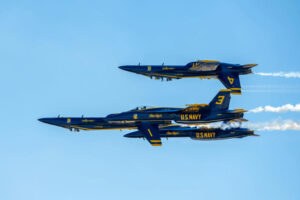JUNE 12, 2023

Fighter jets are known for their supersonic speeds and impeccable maneuvers. One of the key distinctions of fighter jets is their ability to achieve and sustain an inverted flight. The wings must continue to generate lift even in the upside-down position. The design of the wings is such that they are symmetric and equally rounded at the top and bottom. Symmetric wings generate an equal amount of lift in the inverted position without losing speed or altitude.
Notably, the symmetric wing configuration is entirely different than how commercial wings are designed. The top surface is typically rounded, and the bottom is flat. This creates a venturi, causing differing airspeeds on the upper and lower surfaces of the wing. Higher pressure is built underneath the wing, and lower pressure over the wing, resulting in positive lift. If the airplane is inverted, the effect is the opposite, and the wings would naturally generate downward force instead of lift.
An inverted flight can also be sustained if the angle of attack of a slightly asymmetric wing is significantly altered. The higher the angle of attack, the more lift is generated from underneath the wings. That’s why airplane wings are tilted with the leading edge pointed up relative to the oncoming wind; the air is forced to pile up beneath the wings. The velocity of air moving above the wings is greater than the velocity of air beneath them.
An inverted flight
The basics of flight (weight, lift, thrust, and drag) remain the same, irrespective of the normal or inverted flight. The inverted flight, also part of a barrel roll, can be achieved through specific maneuvers performed by the commander. A barrel roll is an aerial maneuver in which an airplane makes a complete rotation on both its longitudinal and lateral axes, causing it to follow a helical path.
Pilots typically begin by rolling in one direction before pulling back on the stick. The g-force acts straight down and inwards. In the upside-down position, pilots apply back-stick pressure to maintain positive Gs. The g-force is kept positive throughout the maneuver, typically between 2 and 3g.
The process of achieving an inverted flight is to have the aircraft rotate along its roll axis. It begins with a rotation along the pitch axis through the application of elevator input, followed by aileron input. At the midpoint of the roll, the aircraft enters the inverted position, and the nose points at roughly a right angle to the general flight path. The plane continues through the roll when flying in the inverted position, descends in altitude, and returns to the original flight path.
Specialized fuel and oil systems
Fighter aircraft that are designed to fly upside down or carry out high-angle maneuvers are equipped with dry sump systems. Such systems do not store any oil itself but rely on pumping systems for oil. Similarly, fuel systems are fitted with pressure pumps that transmit the right amount of fuel even when flying upside down.
Courtesy/Source: SimpleFlying









































































































